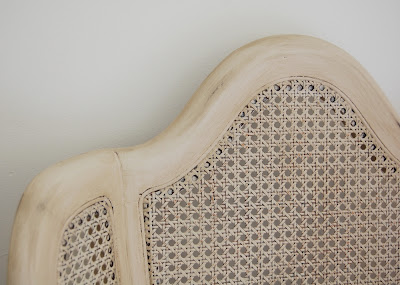I spent the last few days painting my antique cane-back chair. I chose a creamy off-white color with an antique glaze over it. Here's how I did it...
Step 1: Sand
The chair had a thick coat of old yellowed varnish on it, which I didn't fully realize until I began sanding and unleashed a cloud of fine varnish dust. Fortunately, I had taken it outside before I started. Unfortunately, I was sanding it by hand on a 90 degree day. It was a sweaty, dirty, job. But it was well worth it!
Before:
After:
Step 2: Paint
With the nasty old varnish sanded into oblivion, I had a nice smooth wood base to start painting. I covered my coffee table with cardboard and set the chair up on the coffee table to paint it. Raising it off the floor was a huge help!
I didn't use a primer, but 2 coats of paint did a fair job of covering the leftover reddish stain that I didn't completely sand off. I ended up adding a third coat to the arms and a few spot on the back where a pinkish tint was still showing through.
The color I used is called "Buttermilk" from Olde Century Colors.
Step 3: Distress
Next, I used my 100 grit sandpaper again and sanded through just a few of the edges around the legs and arms and back, places where the finish would naturally wear. I don't like to go overboard with distressing, but I wanted a nice antique look.
Step 4: Glaze
To glaze my chair, I choose a Martha Stewart Living color called "Crevecoeur". FYI: I looked it up - apparently "Crevecoeur" is a rare breed of chicken from France. How very Martha. :)
I picked this color because at Home Depot it was one of "Martha's Picks" which meant it was premixed in these handy little 8 oz. sample cans for only $3.00. Easy!
I mixed a little of my French Chicken paint with enough water to get a nice runny mix. The color was a little greener than I was expecting, but it actually worked really well as an antiquing glaze. So often, watered down browns end up looking too orange for my taste, and this one definitely did not.
I brushed the watery glaze onto one section of the chair...
And then wiped off the excess with a damp rag, leaving just a hint of color.
The glaze settles into all the little scratches, so the more you rough up the painted surface before you start, the darker your glaze will end up.
I decided not to replace the old caning with the hole in it. It doesn't bother me as much as I thought it would, and since I'll be using it up against the wall in the bedroom, a pillow covering the front will be good enough for me. Imperfections just add to the charm!
Now on to choosing fabric for the seat and uphostering!























